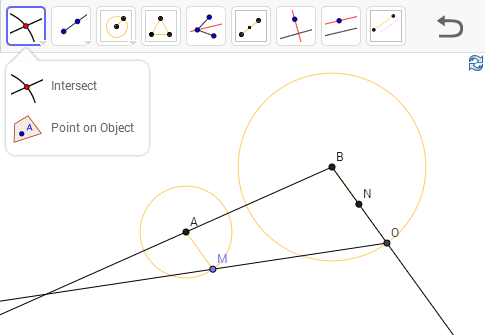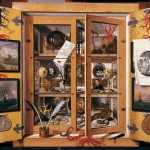There’s a bit of luck in my starting this week’s quick takes late, because it meant I had time to spot this article from Marginal Revolution about a Swiss town trying to hire a hermit. Naturally, I was reminded of this exchange from Tom Stoppard’s Arcadia:
LADY CROOM: You surely do not supply an hermitage without a hermit?
NOAKES: Indeed, madam —
LADY CROOM: Come, come, Mr Noakes. If I am promised a fountain I expect it to come with water. What hermits do you have?
NOAKES: I have no hermits, my lady.
LADY CROOM: Not one? I am speechless.
NOAKES: I am sure a hermit can be found. One could advertise.
LADY CROOM: Advertise?
NOAKES: In the newspapers.
LADY CROOM: But surely a hermit who takes a newspaper is not a hermit in whom one can have complete confidence.
If Euclid the Game didn’t have only twenty levels, I might have turned hermit myself when I found it this week. This is a very well designed game that lets you use virtual compasses and straightedges to construct the midpoint of a line segment, or a circle inscribed in a triangle, etc. Once you master a construction, it gets added to your set of tools, so, once I bisected an angle once, I got a new button added to my topline.
I managed to play through to level 20, but then got stuck. So I’ve peeked at one of the solutions, and I’m going to puzzle out why it works, once I have a pencil and paper on hand, so I can mark it up. In the meantime, I replicated it in-game and was able to modify it and poke around to test my hypothesis. (All wrong, so far).
A friend also recommended another geometrical construction game, once I finish Euclid.
Speaking of exercises in construction, Vanity Fair has a fascinating feature on how the practical effects were pulled off for a particularly gruesome death on Game of Thrones. Here’s the most entertaining, not as spoiler-y, pullquote I could manage:
Gower: We cut to the actor, he was lying down, and the effects department . . . they had several little blood tubes and various gags which they actually put inside [REDACTED] hands, up into his thumbs, so it could pump blood around [REDACTED]’s actual eyes—and he had protection around his eyes.
Bauer: We had to make C.G. thumbs that would stay in the eyes, because the actor playing [REDACTED] was so cautious about getting his thumbs near [REDACTED]’s eyes, that they were always hovering over the top, so we had to get the thumbs really dug far into the prosthetic.
And if you like your grotesqueries spoiler free, perhaps you’ll prefer this NYT feature on the resurgence of taxidermy in England.
While her workshops are popular, they are also controversial; she began to use a pseudonym after receiving death threats and would not give her real name.
“I think that people are interested in the bizarre,” she said during a recent class as she bared a tattoo of a rat on her arm, its bright red tongue matching her hair. “They sit at their desks all day and they stare at a computer, and they want to get into something else and do something manual with their hands and be creative.”
There is a bit of a taboo around dead animals, she said, which adds to the thrill of the class. People want to have a “hands-on experience with death.”
“We don’t have that at all in our culture. It’s sort of Victorian, and it’s quirky,” she said. “Dressing up death is in a way reviving life into something, and that’s what I think is the art in it.”
But if you’d like your artistic endeavors to involve less… skinning, you may want to join Simcha Fisher in her summer project to work through Drawing on the Right Side of the Brain. I’ve done one exercise from this book in high school, and it was a better drawing than anything else I’ve done. The whole thing kicks off this coming Tuesday.
Nautilus has a nice feature on how scientists can tell whether a particular evolutionary kludge is mere happenstance or would be very likely to be repeated if you could roll back the clock, and start again. Of course, for some species, no guesswork is required, just an awful lot of freezers.
Rather than attempt to reconstruct history with fossils, Richard Lenski, an evolutionary biologist at Michigan State University, decided to watch convergence and contingency unfold in real time, in the controlled environment of his laboratory. In 1988, he separated a single population of Escherichia coli bacteria into 12 separate flasks containing liquid nutrients, and let them each evolve separately. Every few months for the past 26 years, he or one of his students has frozen a sample of the bacteria. This archive of frozen microbes gives Lenski the ability to replay E. coli’s tape of life from any point he wishes, simply by thawing out the samples. Along the way, he can examine how the bacteria change both genetically and in ways that are visible under a microscope. Lenski says, “The whole experiment was set up to test how reproducible evolution was.”
…
In 2003, another contingent event took place. The number of E. coli in one of the flasks increased to the point where the normally translucent nutrient solution turned cloudy. At first Lenski thought that the flask had been contaminated, but it turned out that the E. coli, which normally just feed on glucose in the solution, had developed a way to consume a different chemical in the flasks, called citrate. After 15 years, or 31,500 generations, just one of the populations was able to consume the substance.2 Its population size quickly expanded by a factor of five.
This “historical contingency” gave Lenski and his graduate student Zachary Blount a chance to examine the likelihood that it would happen again if they rewound the tape. Blount went to the archive of frozen E. coli, and selected 72 samples collected at different periods in the experiment from the population that later evolved citrate metabolism. He thawed them out, and let them grow. Eventually, four out of the 72 samples acquired the ability. What’s more, the mutations only occurred in populations that had been frozen after 30,500 generations. Genetic analysis showed that several genes had undergone mutations that “potentiated” the evolution of citrate metabolism before that point. In other words, the ability to consume citrate was contingent upon other mutations that had come before it. Those formed a fork in the road, altering the path that generations after would be able to travel.
Finally, I’m very amused to say that I organized a group of fourteen people to see Freud’s Last Session at Theatre J last night and, during the Q&A, the producer mentioned that this two-hander featuring Freud and C.S. Lewis had attracted a different group of theatregoers than other recent productions. “In fact,” he said, “I believe we have a group here tonight,” and he gestured to my bloc of seats. “Where are you all from?”
One of my seatmates piped up, “We’re all here with Leah!” and I just added that I like shanghaiing my friends to shows.
As I was leaving the theatre, a woman stopped me, handed me her business card, and told me that she was an executive at a Maryland theatre, and wanted to me to know she had group rates available as well. This is probably the most I will ever feel like a VIP.
For more Quick Takes, visit Conversion Diary!














